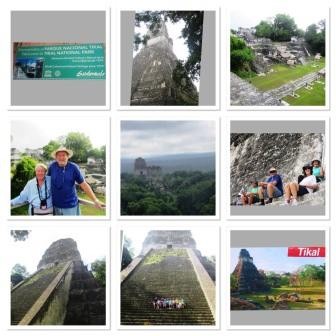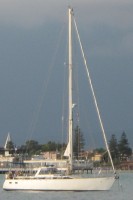
La Aventura with Patti & James
06 July 2018 | Faial Island –Atlantic Portugal
24 June 2018 | National Holiday day in Faial
22 June 2018 | afternoon whale watching boat trip
20 June 2018 | an enjoyable day trip to another island.
19 June 2018 | Fabulous Faial. – Azorean Island
18 June 2018 | Faial Island – Horta Harbour - Mid Atlantic
29 May 2018 | Mid Atlantic - in the middle of nowhere
26 May 2018
26 May 2018 | the cruising yachtsman’s haven
25 May 2018 | party day in Hamilton
10 May 2018 | Vero Beach/Ft Pierce –road trip to Jacksonville.
12 April 2018 | Vibeke onboard
17 March 2018 | lovely to return to Belize and Mexico and meet up with sailing friends along the way
24 January 2018
24 January 2018 | I have become so interested in Guatemala textiles
17 January 2018 | So great to catchup with so many friends and our families
01 November 2017 | what a wonderful Guatemalan fiesta to experience
30 October 2017
29 October 2017 | Volcanic crater
28 October 2017 | Antiqua - Guatemala
TIKAL – Mayan archaeology at its best
27 September 2017 | Guatemala – land travels
a wonderful day

IMAGE – collage Tikal
TIKAL
A visit to Tikal – Guatemala’s most famous Maya ruin, was on our ‘must-do’ list – so when the Ocean Cruising Club (OCC)Port Officer arranged a trip for all the members here in the Rio we were more than happy to join the gang of sailor gringos.
Our visit to the stunning Mayan archaeological site began with a pre-dawn departure from our Casa in El Remate around 5am.Thankfully James woke the still sleeping overnight security man to arrange a quick hot black coffee before boarding our bus. Entry to the park for day visitors opens at 6am –so with our short journey we were there in plenty of time to be first through the gates.
Oliver, a local El Remate man was our tour guide for the day – so he conveniently caught the bus with us and had time on the journey to give us some historical info etc.
The park is approximately 570 square kilometres and the city of Tikal covered an area greater than 16 square kilometres, which included 3,000 structures. Only a fraction of these structures have been uncovered, in what was the centre of the city. Sadly, due to lack of funds, it is unlikely that more temples will be uncovered anytime soon.
The Grand Plaza was beginning to assume its present shape and extent by the time of Christ. Around AD 250 – referred to as the Classic Period, Tikal had become an important religious, cultural and commercial city with a large population – with King Yax Ehb Xooc the founder of the dynasty that ruled Tikal.
The later Kings took the weird and wonderful names such as King Great Jaguar Paw, Lord Water, Moon Double Comb aka An Cacao/ King Chocolate.
By the mid Classic Period Tikal sprawled over 30 sq km and was populated by approx 100,000 industrious natives. It wasn’t until 1848 that the Guatemalan government sent out an expedition to find the site.
Maya civilisation, right back from 700BC boasts an advanced writing system, awe-inspiring engineering feats, advanced mathematics and astrology, and stone-working skills that remain mysterious and impressive to this day. This great ceremonial and cultural centre gained and lost importance as the empire and its individual kingdoms ebbed and waned.
Sadly many legacies of the Maya have disappeared over time. Archaeological pieces have been carried off by either tomb raiders or foreign governments, and much cultural heritage has been lost over the centuries due to government and church campaigns to assimilate the Maya into mainstream Hispanic culture. In 1877 one of the earliest Swiss explorers (exploiters) removed sacred carved wooden lintels from Temple I and IV- they are now on display in a Basel museum. Most recently the Guatemala government has given permission for centuries old pieces to be ‘replaced’ by the Japanese government archaeologists as payment for their conservation and exploration work , resulting in many items being taken to Japanese museums. Since 1991 a joint Guatemala – Spanish project has worked on restoring Temples I and V. The Parque National Tikal was declared a Unesco World Heritage Site in 1979.
Our visit was a true step back in time. The most striking feature of Tikal is its towering, steep-sided temples – but what distinguishes it is its jungle setting. Many of the plazas have been cleared of trees and vines, its temples uncovered and partially restored. As we walked in the cool of the early morning from one area to another we passed beneath the dense canopy of the rainforest. Oliver was truly a combined archaeologic and nature guide – he kept spotting and hearing various bird species, pointing out small insects and the prize of the day was spotting a wild toucan. We spotted some very happy spider monkeys high up in the forest canopy, and a few howler monkeys that glared down on us as we marvelled at them. There were the odd wandering accolated turkeys in amongst the bush of the marked trails.
When we visited the Mayan sites of Coba and Tulum in Mexico earlier in the year I found the steep- sided pyramids far too strenuous for me to attempt to climb - but thankfully here in Tikal solid wooden staircases with handrails have been erected to allow visitor to climb in safety and also to preserve the structures. Wow - we could get to the top of the towering 70m Temple IV at the western edge with no problems.
Tikal is a vast, complicated site with hundreds of temples, pyramids and stelae (stone inscriptions). The architecture of the city was built from locally quarried limestone and includes the remains of temples that tower over 70 metres high, large royal palaces, in addition to a number of smaller pyramids, palaces, residences, administrative buildings, platforms and inscribed stone monuments. The limestone was quarried onsite. While some sites are little more than a pile of rubble or some grassy mounds – the temples, plazas and ballcourts that have been excavated give an excellent insight into what life must have been like to live in these places. Tikal’s greatness waned around the mid 900’s AD around the time of the general collapse of lowland Maya civilisation. It is believed that the reasons that led to the Mayans eventually abandoning the site was due to over population, deforestation, erosion and nutrient loss. Tikal also had a water problem – there was no natural water source, surviving only on rainwater collected and stored in reservoirs.
Our small group strolled along the ancient causeways, with Oliver giving us info along the way.
The Ceiba Tree is not only Guatemala's National Tree, but it is the sacred tree of the Maya. Some species can grow to 70m or more and have a straight, largely branchless trunk with a huge spreading canopy and buttress roots that can be taller than a grown person. For the Maya, the tree represents the ‘axis mundi’, the stable world centre. It constitutes a symbolic vertical line. The line of balance that unites the three realms of the underworld, the earth and the heavens. It is considered a 'Tree of Life' by the Maya. The axis mundi is the 'navel of the world' and is an important symbol to both Guatemala and the Maya.
Temple I is known as the Temple of the Grand Jaguar. It was built to bury and honour King Ah Cacao (King Chocolate). The temple was erected above his tomb and the King's rich burial goods included stingray spines, which were used for blood-letting, 180 jade objects and 90 pieces of bone carved with hieroglyphs. At the top of the 44m temple is a funerary shrine. The roof comb that crowned the temple was originally adorned with reliefs and bright paint.
Temple II is located on the west side of the Gran Plaza. It was built by King Ah Cacao in honour of his wife. It is the most thoroughly restored of the major temples at Tikal. We were able to climb to the top of this temple. Two badly eroded giant masks adorn the upper platform and give the temple its other name of The Temple of Masks. The roof comb is highly ornate and bears the sculpture of a face with circular ear spools.
Temple IV is a Mesoamerican pyramid. It was one of the tallest buildings in the Maya World. The pyramid is 64.6 metres high and rises way above the jungle canopy, affording spectacular views over the whole site. The wide vista was just stunning - high above the tree line was what you could expect from the low flying helicopter tour. To see Temples 1, II & III poking up through the dense jungle canopy in the early morning mist was as awesome sight.
Temple V is the most recently excavated Temple and stands at 187 feet high. It is actually a mortuary pyramid of an as yet unknown ruler. We were able to actually climb to step number 9 on the outer façade – a fitting location for a group photo, and great memories for many years to come.
Comments
| Vessel Name: | La Aventura |
| Crew: | James & Patti |
Gallery not available

Who: James & Patti